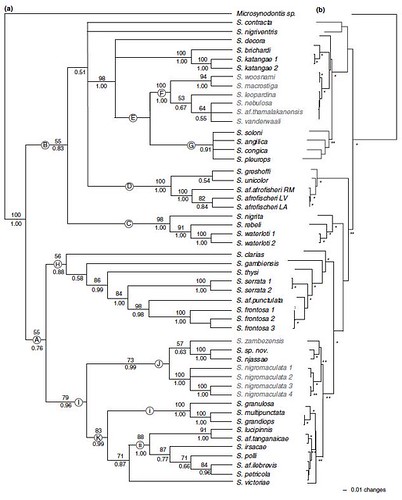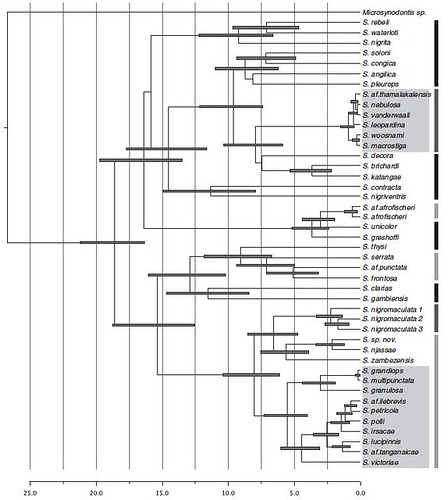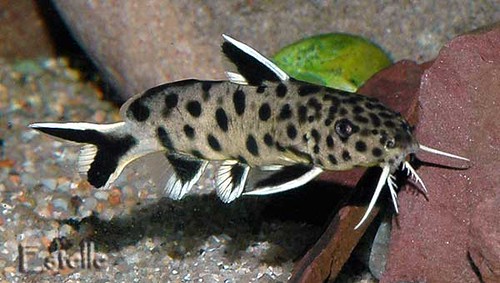tags: evolutionary biology, speciation, species flocks, molecular phylogeny, behavioral ecology, Synodontis species, squeaker catfish, cuckoo catfish, Lake Tanganyika, peer-reviewed paper
The Cuckoo Catfish, Synodontis multipunctatus [Siluriformes: Mochokidae].
This is the only fish that is a known brood parasite.
This is one of the species included in this newly-published study.
Image: orphaned.
One of the groups of fishes that I worked with as an aquarist for nearly my entire life are the synodontids, often known as "squeaker catfish" for their ability to make high-pitched sounds. These medium- to large-sized African catfishes are attractive, long-lived and intelligent, and many species in this genus exhibit a variety of distinctive breeding behaviors. For example, S. multipunctatus (pictured above) is the only fish documented to practice brood parasitism: it sneaks its eggs in with those of mouthbrooding cichlids in Lake Tanganyika, and its larvae grow faster than those of the host and feed on them. Add that to a fascinating evolutionary history, which is still being deciphered, and you have a very interesting group of fishes.
The synodontid catfish are endemic throughout many of the lakes and rivers of sub-Saharan Africa, including Lake Tanganyika. Located in the famous Great Rift Valley of central Africa (see map, below), Lake Tanganyika is one of the largest and deepest freshwater lakes in the world, and is home to at least 250 species of cichlid fish and 150 non-cichlid species, nearly all of them unique.
Image: Safari Tours Online [larger view].
Because of its isolation, Lake Tanganyika is one of several aquatic islands in the Great Rift Valley, and is home to numerous groups of closely related species, known as "species flocks". These species flocks evolved rapidly and in genetic isolation from their close relatives through a process known as adaptive radiation and thus, they are important for helping scientists further understand the process of speciation. Some examples of especially famous species flocks include Darwin's Finches, the Hawaiian Honeycreepers, and of course, the cichlid (SICK lid) fishes found in Lake Tanganyika and several other Great Rift Valley lakes.
Synodontis catfishes share several similarities with the cichlids, including their geographic distribution and their overall species richness, so it is logical to conclude that the synodontids are a useful comparative model system for studying speciation in cichlids. But surprisingly, the evolution of Synodontis catfish remains controversial and poorly known. For example, two independent pilot studies published in 2006 generated conflicting data regarding the colonization history of Lake Tanganyika and molecular relationships among synodontids (Figure 1);
Figure 1 [larger view]
To address these inconsistencies, it is necessary to conduct further research by adding more DNA regions from more taxa to the analysis. So a research team, headed by JJ Day, investigated the relationships between these species and tested whether these fish are monophyletic -- that is, if they descended from one common ancestor -- by analyzing the nuclear (nc)DNA and mitochondrial DNA (mtDNA) from 65 individuals of roughly 40 species (some species are cryptic) to reconstruct a molecular phylogeny for all the Tanganyika synodontids as well as those most major African drainage basins (Figure 2);
Fig. 2 Phylogenetic hypotheses of Synodontis relationships inferred from mtDNA (cytochrome b + tRNA) and ncDNA (rpS7 intron 1). (a) Consensus of maximum likelihood tree and Bayesian (MRBAYES) consensus. Support values above 50% are shown for bootstrap (above branches) and Bayesian posterior probabilities (below branches). (b) Bayesian consensus based on P4 analysis employing compositional heterogeneity model and a strong polytomy prior. Support values > 81 indicated by **(81-90), *(91-100). Southern African species are highlighted by grey taxon names. [larger view]
Despite using two different analytic methods, the team recovered the same phylogenetic tree with only minor differences. For example, the two main clades, A and B, are consistently recovered, and the Lake Tanganyika synodontids are consistently recovered as a single clade (K), while species that are endemic to Lake Malawi cluster together with riverine species from the Zambezi and Okavango drainage basins (clade J). Most -- but not all -- south African species form a distinct lineage (clade F) that evolved from Congolese ancestors that hybridize under laboratory conditions, suggesting that this a very young species flock. The 'East African' lineages (clade I) lack strong statistical support and are poorly resolved, probably due to rapid speciation in this group. Further, even though these data reveal that the Synodontis catfish are monophyletic, several geographically clumped species clades are not monophyletic, indicating a more complex evolutionary history than previously thought.
The team then investigated the evolutionary history of Synodontis species by calibrating their maximum and minimum dates from the Burdigalian period (16.3 - 21.5 Myr), from a fossil Synodontis (Figure 2);
Fig. 3 Chronogram inferred from Bayesian dating analysis (BEAST) of the combined data set. Node bars indicate 95% posterior distributions. Grey boxes indicate lacustrine radiations. Light grey: East African taxa; Mid-grey: southern African taxa; Dark grey: central and West African taxa. Time in Myr. [larger view]
According to the above chronogram, the inferred timing of the Synodontis radiation corresponds to the deepening of Lake Tanganyika, which occurred around 5-6 Myr, with the two endemic clades diversifying during a time when Lake Tanganyika experienced lower lake levels due to climate change. Similarly, all the major cichlid tribes were estimated to have radiated at roughly the same time.
However, several questions remain to be addressed:
- Since it appears that Synodontis evolved in the now-extinct lake basin in the Great Rift Valley, why are there no Synodontis species flocks in either Lakes Malawi or Victoria?
- Why don't Synodontis have multiple species flocks in Lake Tanganyika, as seen in cichlids?
- Even though they apparently arose at similar times, why do cichlids show such tremendous morpholical diversity while Synodontis do not?
By investigating these and more questions for Synodontis and the cichlids, scientists will gain a clearer idea of how geography influences speciation differently in two lineages that share a similar evolutionary history.
False Cuckoo Catfish (because it is often confused with the Cuckoo Catfish, S. multipunctatus)
also known as the Dwarf Lake Synodontis, Synodontis lucipinnis [Siluriformes: Mochokidae].
This is another Lake Tanganyika species included in this study.
Image: Destination Tanganyika [larger view].
Source:
DAY, J., BILLS, R., & FRIEL, J. (2009). Lacustrine radiations in African Synodontis catfish. Journal of Evolutionary Biology, 22 (4), 805-817 DOI: 10.1111/j.1420-9101.2009.01691.x.







I kept a few different species of synodontis catfish when I had aquariums. They are fascinating animals.
Here's a video of the catfish in action. Really interesting.
Synodontis are really neat little guys. The old family tank had a little dark coloured one for years that had been sold as an upside-down catfish (Synodontis nigriventis) but obviously wasn't.
I don't have anything for number one but for number 2/3 I would suspect that it is something generalizable about the basic catfish morphology that is suited to make them really good at only a few things. Catfish are extremely widespread in freshwater (and many saltwater) ecosystems throughout the world. A lot of these have a couple to a handful of species in any one place. So in North America we have the Ictalurids. At any one place there are maybe 1 - 3 catfish doing their thing but many times more perciformes. It seems like with the perciform (incl. cichlid) body plan with their protrusable premaxilae and what-not there are just more niches that they are able to specialize into.
The exception to this is South America with the Loricaridae et al. There is a catfish family that blows Cichlidae out of the water. I'm not sure what caused catfishes to be so diverse in South America even though there are Cichlids there too. The loricaridae, with their specially adapted mouths, may represent a breakthrough adaptation (like the protrusable maxilae of cichlids) that is amenable to many different niches.
I have a suspicion that the fish at the top of your page is actually S. grandiops, which was separated from S. multipunctatus a couple of years ago. S. grandiops>/i> is still sold in the shops as S. multipunctatus, and indeed is the name I bought mine under. I'm 99% sure my nine "multipunks" are S. grandiops instead, and the photo looks pretty much the same. S. multipunctatus have a few differences, including that they grow substantially larger (25cm instead of 15cm).
Keeping track of the correct name for your fish is confusing when you're into Rift Lake cichlids and synodontids. I've had the same problem with my Cyphotilapia frontosa actually being C. gibberosa. It also means that I have to find some true S. multipunctatus for my collection, and set up another tank.
I love S. multipunctatus. I have 4. One is captive bred & 3 are wc from burundi. Im curious to see what pattern differences there are in multi's since they are so wide spread. Like the Tropheus species, theres many geographical varieties. How much does the cuckoo cat varied throughout the lake? Heres a link to mine. One of which someone thinks is grandiops. Please feel free to post your opinions.